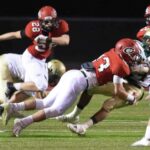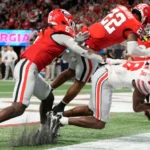Tacking is not an issue I tackle a lot on this blog but I should. The emphasis around here is on coverage and being in the right place to make a play on the ball when it is thrown. However, tackling in the secondary has taken on even greater importance in this modern era of offenses.
The advent of spread offenses and wide open passing attacks have sought to make use of space. This means, more and more offenses are seeking to get the ball into the hands of their playmakers quickly, in space and allow their athletes to use their talent to avoid / break tackles. Often times, the throws to the athletes occur behind the line of scrimmage making it difficult for you to deny the throw. This means that in order for you to be successful against the play, you will need to make a solid tackle to avoid a big gain.
In this article we will discuss some important factors and tips that will take your tackling from subpar to high quality.
Proper Stance and Alignment
Tackling begins before you even make contact with the ball carrier. Ensure you start with the correct stance and alignment. Lower your hips, bend your knees, and keep your weight on the balls of your feet. This stance allows for quick reactions and better balance.
Position yourself correctly relative to the ball carrier and your teammates. Maintain leverage and take the appropriate angle to make the tackle effectively. A lot of times a tackle will feel like it’s one on one but when you are a savvy player, you know how to use the pursuit of your teammates and or the sidelines to help you cut off a player’s path. This is similar to what you do in man coverage.
Breakdown and Gather
Before making a tackle, it’s crucial to break down and gather yourself. This involves slowing down, maintaining balance, and preparing to make the tackle. When closing in on the ball carrier, slow down and take shorter, controlled steps. This gives you the ability to change direction or react to the ball carrier’s moves.
Keep your shoulders square to the line of scrimmage and the ball carrier. This prevents the ball carrier from easily sidestepping your tackle attempt. The idea is to make yourself big as you approach. Staying square as opposed to turning sideways does that. It also allows you to break left or right vs. a move made by the ball carrier. You will find this principle similar to what you do in press coverage at the line of scrimmage.
Wrap-Up Tackling
Wrap-up tackling is a fundamental technique that involves securing the ball carrier and bringing them to the ground. Aim for the ball carrier’s midsection or thighs. This is the most effective area to tackle, as it reduces the chance of missing the tackle or allowing additional yards after contact. Going high runs the risk of helmet to helmet contact which can numb your ability to finish the play. It also sets you up for a stiff arm or quick upper body maneuver by the ball carrier.
After making contact, wrap your arms securely around the ball carrier. Squeeze tightly, using your chest and shoulders to add pressure. This restricts the ball carrier’s ability to break free. Then use your legs to drive through the tackle. Lift with your hips and explode upward, taking the ball carrier off their feet and driving them backward. That last part is one the one most tacklers forget. The tackle is not over once you wrap your arms. Using your lower body to drive the ball carrier is what elite tackler all understand.
Avoiding Tackle Breakers
In addition to mastering wrap-up tackling, it’s essential to minimize the ball carrier’s chances of breaking free. Keep your head up and to the side, not down. This prevents helmet-to-helmet collisions and minimizes the risk of injury. You have to see what you’re hitting. You also don’t want to take yourself out of the game by getting a stinger, concussion or something worse. Maintain a low center of gravity and keep your hips down when making contact. This helps you gain leverage and prevents the ball carrier from running through the tackle.
Recognition and Reaction
Tackling also involves recognizing the type of play, anticipating the ball carrier’s movements, and reacting quickly. Pay close attention to the play unfolding in front of you. Anticipate where the ball carrier is likely to go and prepare to make your move. Understand pursuit angles. Position yourself so that you can cut off the ball carrier’s path and limit their options. This is where football IQ comes in. Sometimes it’s just as simple as picking up a tendency a ball carrier has. Some guys love to cut back and others are all about using their speed to get by you. Knowing who you are dealing with allows you to put yourself in better position.
Tackling Drills
Regular practice is essential to improve your tackling skills. Incorporate tackling drills into your training regimen to refine your technique, build confidence, and enhance your ability to tackle under pressure. Most defensive backs do nothing with regards to tackling until the season starts. Just because you are not in pads in the offseason does not mean you can’t work on your tackling skills. Use tackling dummies, heavy bags and even drills just fitting up on the goal post can improve your tackling by leaps and bounds.
Becoming a proficient tackler as a defensive back requires a combination of technique, mindset, and practice. By focusing on your stance and alignment, mastering wrap-up tackling, developing recognition and reaction skills, you can significantly improve your ability to make open-field tackles.
You don’t want to become a liability to your team by having poor tackling skills. The truth of the matter is that if an offense realizes they can get 10 yards every time by throwing a wide receiver screen or quick hitch to your side then that’s all you are ever going to get. What DB wants that?
Regular practice and a commitment to honing your tackling skills will make you a valuable asset to your football team and a formidable presence on the defensive side of the ball. You will truly be able to call yourself a playmaker.
Chad Wilson is the owner of All Eyes DB Camp and author of "101 DB Tips". He played college football at the University of Miami and briefly in the NFL for the Seattle Seahawks. Over his 15 year high school football coaching career, he tutored over a dozen Division I defensive backs and as a trainer has worked with NFL All Pros, first round draft picks, college football All Americans and Top 10 ranked high school football prospects.









